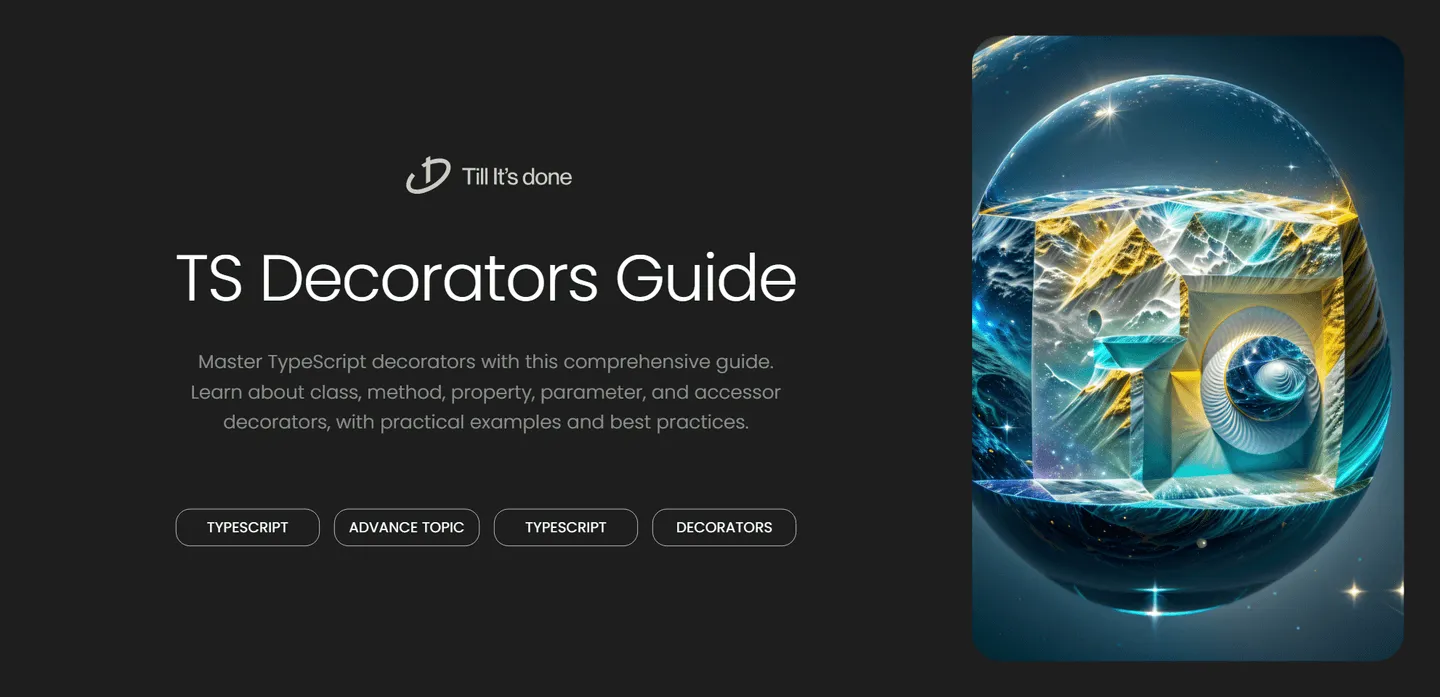- Services
- Case Studies
- Technologies
- NextJs development
- Flutter development
- NodeJs development
- ReactJs development
- About
- Contact
- Tools
- Blogs
- FAQ
TypeScript Decorators: A Deep Dive into Advanced TS
Learn about class, method, property, parameter, and accessor decorators, with practical examples and best practices.


TypeScript Decorators: Deep Dive
Ever found yourself writing repetitive code patterns in TypeScript and wished there was a more elegant way to handle them? Enter TypeScript decorators – a powerful feature that allows you to add metadata, modify behavior, or transform your code in a clean, declarative way.
Understanding the Basics
Decorators are special kinds of declarations that can be attached to class declarations, methods, properties, or parameters. Think of them as “wrappers” that can modify or enhance the behavior of your code. They’re prefixed with the @ symbol and can be used to implement cross-cutting concerns like logging, validation, or dependency injection.

Types of Decorators
Let’s explore the five main types of decorators in TypeScript:
1. Class Decorators
Class decorators are applied to the constructor of the class and can be used to observe, modify, or replace class definitions. They’re perfect for implementing patterns like dependency injection or adding metadata to your classes.
function Logger(logString: string) { return function(constructor: Function) { console.log(logString); console.log(constructor); };}
@Logger('Logging - Person')class Person { name = 'Max';
constructor() { console.log('Creating person object...'); }}2. Method Decorators
Method decorators allow you to observe, modify, or replace a method definition. They’re commonly used for logging, measuring performance, or adding validation logic.
function Log(target: any, propertyName: string, descriptor: PropertyDescriptor) { const originalMethod = descriptor.value;
descriptor.value = function(...args: any[]) { console.log(`Calling ${propertyName} with args: ${args}`); const result = originalMethod.apply(this, args); console.log(`Result: ${result}`); return result; };}
class Calculator { @Log multiply(a: number, b: number) { return a * b; }}
3. Property Decorators
Property decorators let you observe or modify property definitions. They’re useful for implementing validation rules or transforming property values.
function ValidateLength(min: number, max: number) { return function(target: any, propertyName: string) { let value: string;
const descriptor: PropertyDescriptor = { get() { return value; }, set(newValue: string) { if (newValue.length < min || newValue.length > max) { throw new Error(`${propertyName} must be between ${min} and ${max} characters`); } value = newValue; } };
Object.defineProperty(target, propertyName, descriptor); };}
class User { @ValidateLength(3, 10) name: string;}4. Parameter Decorators
Parameter decorators are applied to the parameters of a method or constructor. They’re perfect for dependency injection or parameter validation scenarios.
5. Accessor Decorators
These decorators are specifically for getters and setters. They can be used to modify how properties are accessed or to add validation logic.
Best Practices and Tips
- Keep decorators focused and single-purpose
- Use decorator factories when you need configuration
- Consider performance implications
- Document your decorators thoroughly
- Test decorator behavior independently
Real-world Applications
Decorators shine in many practical scenarios:
- API route handling in frameworks like NestJS
- Validation and type checking
- Dependency injection
- Logging and monitoring
- Caching implementations
- Authentication and authorization

Conclusion
TypeScript decorators are more than just syntactic sugar – they’re powerful tools that can make your code more maintainable, readable, and efficient. While they might seem complex at first, understanding and implementing them can significantly improve your TypeScript applications.
Remember to use them judiciously and always consider whether a decorator is the best solution for your specific use case. Happy coding!
 สร้างเว็บไซต์ 1 เว็บ ต้องใช้งบเท่าไหร่? เจาะลึกทุกองค์ประกอบ website development cost อยากสร้างเว็บไซต์แต่ไม่มั่นใจในเรื่องของงบประมาณ อ่านสรุปเจาะลึกตั้งแต่ดีไซน์, ฟังก์ชัน และการดูแล พร้อมตัวอย่างงบจริงจาก Till it’s done ที่แผนชัด งบไม่บานปลายแน่นอน
สร้างเว็บไซต์ 1 เว็บ ต้องใช้งบเท่าไหร่? เจาะลึกทุกองค์ประกอบ website development cost อยากสร้างเว็บไซต์แต่ไม่มั่นใจในเรื่องของงบประมาณ อ่านสรุปเจาะลึกตั้งแต่ดีไซน์, ฟังก์ชัน และการดูแล พร้อมตัวอย่างงบจริงจาก Till it’s done ที่แผนชัด งบไม่บานปลายแน่นอน  Next.js สอน 14 ขั้นตอนเบื้องต้น: สร้างโปรเจกต์แรกใน 30 นาที เริ่มต้นกับ Next.js ใน 14 ขั้นตอนเพียงแค่ 30 นาที พร้อม SSR/SSG และ API Routes ด้วยตัวอย่างโค้ดง่าย ๆ อ่านต่อเพื่อสร้างโปรเจ็กต์แรกได้ทันทีที่นี่
Next.js สอน 14 ขั้นตอนเบื้องต้น: สร้างโปรเจกต์แรกใน 30 นาที เริ่มต้นกับ Next.js ใน 14 ขั้นตอนเพียงแค่ 30 นาที พร้อม SSR/SSG และ API Routes ด้วยตัวอย่างโค้ดง่าย ๆ อ่านต่อเพื่อสร้างโปรเจ็กต์แรกได้ทันทีที่นี่  วิธีสมัคร Apple Developer Account เพื่อนำแอปขึ้น App Store ทีละขั้นตอน อยากปล่อยแอปบน App Store ระดับโลก มาอ่านคู่มือสมัคร Apple Developer Account พร้อมเคล็ดลับ TestFlight และวิธีอัปโหลดที่ง่ายในบทความเดียวนี้ได้เลย
วิธีสมัคร Apple Developer Account เพื่อนำแอปขึ้น App Store ทีละขั้นตอน อยากปล่อยแอปบน App Store ระดับโลก มาอ่านคู่มือสมัคร Apple Developer Account พร้อมเคล็ดลับ TestFlight และวิธีอัปโหลดที่ง่ายในบทความเดียวนี้ได้เลย  TypeScript Interface คืออะไร? อธิบายพร้อมวิธีใช้และข้อแตกต่างจาก Type เรียนรู้วิธีใช้ TypeScript Interface เพื่อสร้างโครงสร้างข้อมูลที่ปลอดภัยและเข้าใจง่าย พร้อมเปรียบเทียบข้อดีข้อแตกต่างกับ Type ที่คุณต้องรู้ ถูกรวมเอาไว้ในบทความนี้แล้ว
TypeScript Interface คืออะไร? อธิบายพร้อมวิธีใช้และข้อแตกต่างจาก Type เรียนรู้วิธีใช้ TypeScript Interface เพื่อสร้างโครงสร้างข้อมูลที่ปลอดภัยและเข้าใจง่าย พร้อมเปรียบเทียบข้อดีข้อแตกต่างกับ Type ที่คุณต้องรู้ ถูกรวมเอาไว้ในบทความนี้แล้ว  Material-UI (MUI) คืออะไร อยากสร้าง UI สวยงามและเป็นมืออาชีพในเวลาอันรวดเร็วใช่ไหม มาทำความรู้จักกับ Material-UI (MUI) ที่ช่วยให้คุณพัฒนาแอปพลิเคชันบน React ได้ง่ายและดูดีในทุกอุปกรณ์
Material-UI (MUI) คืออะไร อยากสร้าง UI สวยงามและเป็นมืออาชีพในเวลาอันรวดเร็วใช่ไหม มาทำความรู้จักกับ Material-UI (MUI) ที่ช่วยให้คุณพัฒนาแอปพลิเคชันบน React ได้ง่ายและดูดีในทุกอุปกรณ์  เปรียบเทียบ 3 วิธีติดตั้ง install node js บน Ubuntu: NVM vs NodeSource vs Official Repo แบบไหนดีที่สุด? เรียนรู้วิธีติดตั้ง Node.js บน Ubuntu ด้วย NVM, NodeSource หรือ Official Repo เลือกวิธีที่เหมาะกับความต้องการของคุณ พร้อมเปรียบเทียบ เพื่อการพัฒนาที่มีประสิทธิภาพ!
เปรียบเทียบ 3 วิธีติดตั้ง install node js บน Ubuntu: NVM vs NodeSource vs Official Repo แบบไหนดีที่สุด? เรียนรู้วิธีติดตั้ง Node.js บน Ubuntu ด้วย NVM, NodeSource หรือ Official Repo เลือกวิธีที่เหมาะกับความต้องการของคุณ พร้อมเปรียบเทียบ เพื่อการพัฒนาที่มีประสิทธิภาพ! Talk with CEO
We'll be right here with you every step of the way.
We'll be here, prepared to commence this promising collaboration.
Whether you're curious about features, warranties, or shopping policies, we provide comprehensive answers to assist you.


